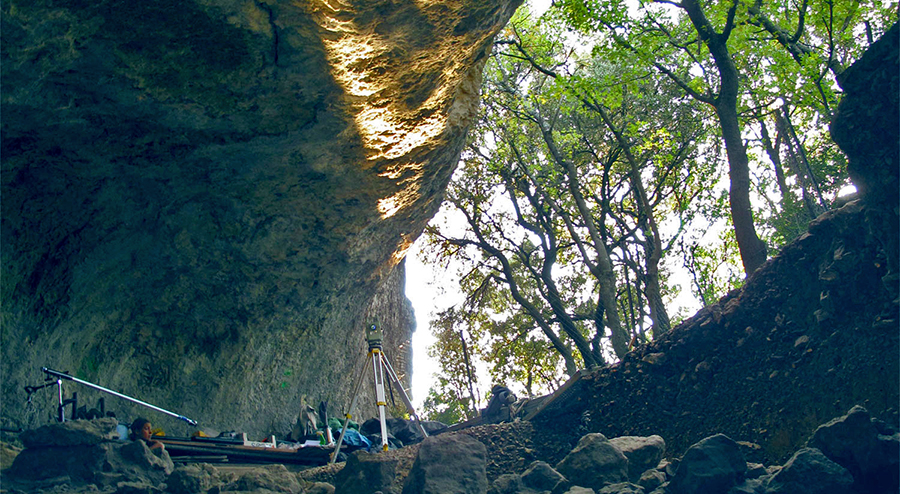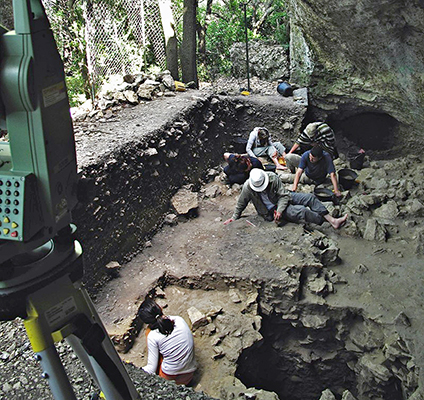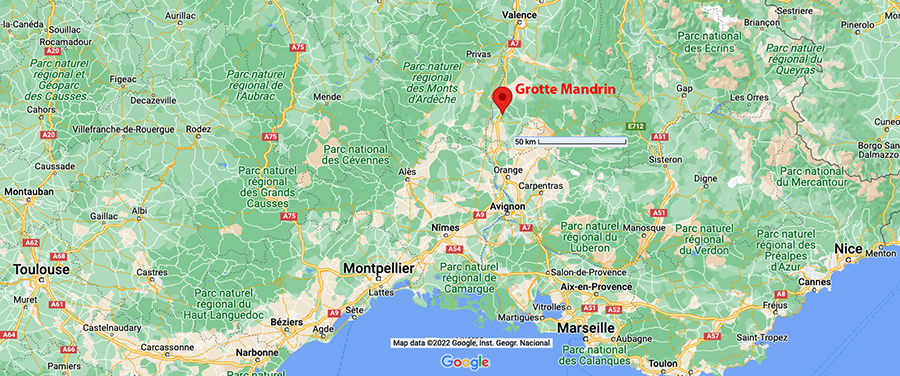Back to Don's Maps
 Back to the review of hominins
Back to the review of hominins
Grotte Mandrin - The first Homo sapiens in Europe?

Grotte Mandrin, France.
Photo: Ludovic Slimak
Source: Slimak et al. (2022)
Archaeologists have found evidence that Europe’s first Homo sapiens lived briefly in a rock shelter in southern France — before mysteriously vanishing.
A study published 9th February in Science Advances1 argues that distinctive stone tools and a lone child’s tooth were left by Homo sapiens during a short stay, some 54 000 years ago — and not by Neanderthals, who lived in the rock shelter for thousands of years before and after that time.
The Homo sapiens occupation, which researchers estimate lasted for just a few decades, pre-dates the previous earliest known evidence of the species in Europe by around 10 000 years.
But some researchers are not so sure that the stone tools or tooth were left by Homo sapiens. “I find the evidence less than convincing,” says William Banks, a palaeolithic archaeologist at the French national research agency CNRS and the University of Bordeaux.
A team co-led by Ludovic Slimak, a cultural anthropologist at CNRS and the University of Toulouse-Jean Jaurès, has spent the past three decades excavating the Grotte Mandrin rock shelter in the Rhône Valley. The researchers have uncovered tens of thousands of stone tools and animal bones, as well as 9 hominin teeth, all dating from around 70 000 to 40 000 years ago.
Most of the stone tools resemble artefacts categorised as 'Mousterian technology' that are found at Neanderthal sites across Eurasia, says Slimak. But one of the shelter’s archaeological levels — known as layer E and dated to between 56 800 and 51 700 years ago — contains tools such as sharpened points and small blades that are more typical of early Homo sapiens technology. Slimak says the layer E stone tools resemble those found at much younger sites in southern France, left by makers unknown, as well as those from similarly aged sites in the Middle East that are linked to Homo sapiens.
Text above adapted from: Callaway (2022)
Neronian points
Neronian points from Mandrin layer E. Micro- and nanopoints (numbers 1 to 23), pointed micropoint (number 10), and points (numbers 24 to 33).
Photo: Laure Metz and Ludovic Slimak
Source: Slimak et al. (2022)

Excavations at the Grotte Mandrin rock shelter uncovered stone tools, animal bones and hominin teeth.
Photo: Ludovic Slimak
Source: Callaway (2022)
General map showing the approximate location of Grotte Mandrin.
Photo: © 2022 Google, Inst. Geogr. Nacional
Grotte Mandrin is about 5 km to the east of the Rhône River, and about ten km south of the town of Montélimar.
Photo: © 2022 Google, Inst. Geogr. Nacional
References
- Slimak L. et al., 2022: Modern human incursion into Neanderthal territories 54 000 years ago at Mandrin, France, Science Advances, 9 Feb 2022, Vol 8, Issue 6, DOI: 10.1126/sciadv.abj9496
- Callaway E., 2022: Evidence of Europe’s first Homo sapiens found in French cave, Stone artefacts and tooth pre-date the earliest known evidence of the species in Europe by more than 10,000 years, Nature, 9 Feb 2022, (draft) https://www.nature.com/articles/d41586-022-00389-9?proof=t


